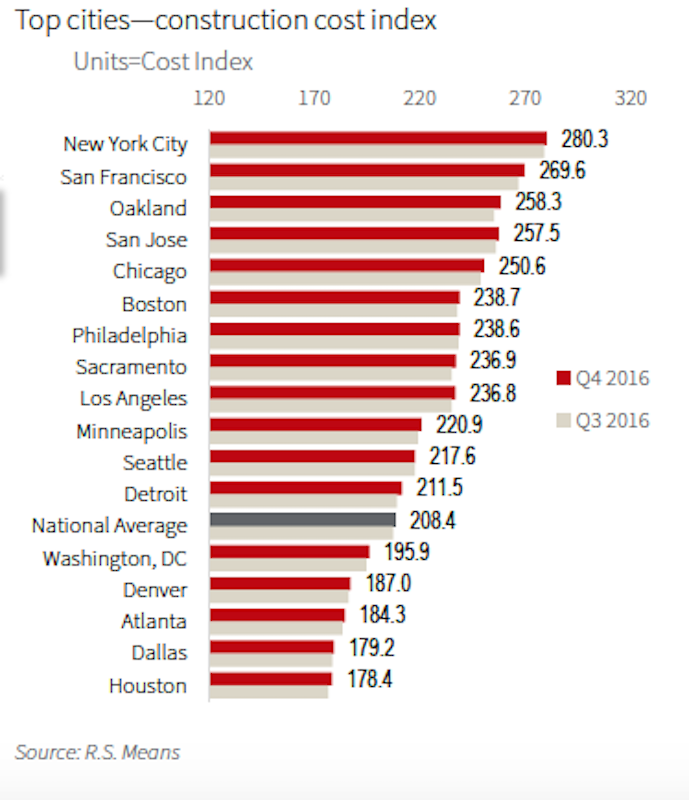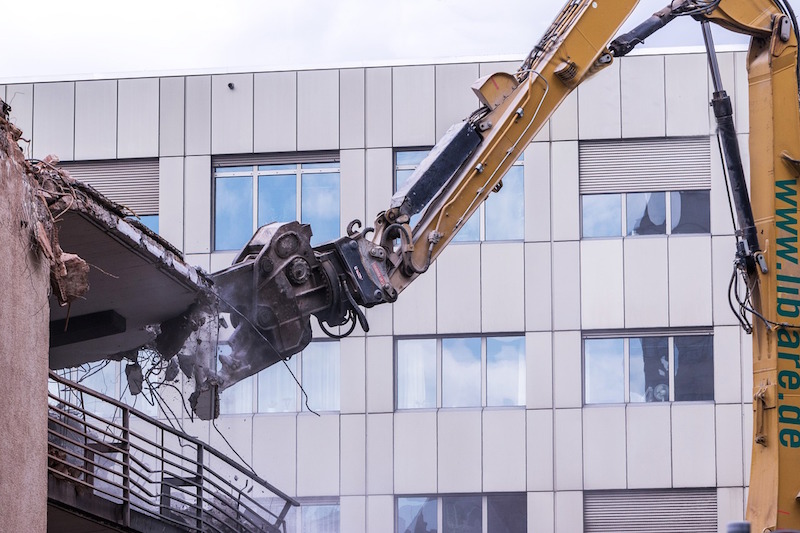The new Trump Administration’s aggressive policies, particularly on international trade and immigration reform, could, if executed as planned, “greatly affect” how America’s construction industry does business this year and beyond.
In its Q4 2016 Construction Outlook, which it released earlier this week, JLL also continued to see construction labor as a “pain point” for the industry that will cause wages to rise and impact project timelines and budgets. And materials costs, which for the most part stabilized in the latter months of 2016, should hold steady if, as expected, construction activity slows this year.
Twenty-sixteen was a banner year for construction spending. Led by the hotel and office sectors, spending increased over the previous year by 4.5% to $1.2 trillion. That rate of growth was nearly triple the GDP inflation rate.
Nationally, the construction and contractor backlog in Q4 2016 stood at 8.7 months of future work across all sectors, up 2.2 percent from the fourth quarter 2015 and tracking closely with national trends. The Midwest in particular enjoyed sizable year-over-year growth that quarter, while work in the South remains steady. The Northeast and West regions continued to slip, each well below 2015 levels.

Not surprisingly, construction costs are rising faster in metros where construction activity has been robust, but also where labor is in shorter supply. Image: JLL Research
Building costs rose nationally by a modest 2.7%, with nearly half of that increase occurring in the fourth quarter, spurred by strong residential construction that drove demand, and uncertainly surrounding the effects of the Trump presidency.
JLL doesn’t expect the manifestations of policy decisions coming out of Washington to intervene on the construction industry until later this year. But JLL’s forecast strikes a cautionary pose about the prospects of “voided international trade deals and new import tariffs [that] could drive up materials costs faster.”
And at a time when construction unemployment continues to fall—last week, AGC America reported that from January 2016 to January 2017 construction employment rose in 39 states and in 216 of 358 metro areas—immigration reform “could shrink the skilled labor supply and spur further wage increases,” says JLL’s report. Large-scale infrastructure projects will create a premium on materials and workforce in specific markets such as Oakland and San Francisco, Chicago, and New York.
Inflation in materials costs is harder to gauge when trade agreements are in flux. The largest price swings in 4Q 2016 were seen on the cement and lumber fronts: cement costs were down 4.7% compared to the same time last year, while lumber was priced 9%-plus higher. Steel, on the other hand, maintained negligible price changes, not even breaking one-tenth of a percentage point over third-quarter prices.
One barometer worth keeping an eye on is the IHS Markit PEG Engineering and Construction Cost Index, which tracks procurement activity among engineering and construction firms. In March, that Index registered its fifth consecutive month of rising prices.
Eight of 12 materials/equipment categories tracked showed rising prices in March. And the six-month expectation index stayed positive, although materials and equipment prices are projected to rise at a slower pace than subcontractor labor.
Related Stories
Multifamily Housing | Feb 7, 2023
Multifamily housing rents flat in January, developers remain optimistic
Multifamily rents were flat in January 2023 as a strong jobs report indicated that fears of a significant economic recession may be overblown. U.S. asking rents averaged $1,701, unchanged from the prior month, according to the latest Yardi Matrix National Multifamily Report.
Market Data | Feb 6, 2023
Nonresidential construction spending dips 0.5% in December 2022
National nonresidential construction spending decreased by 0.5% in December, according to an Associated Builders and Contractors analysis of data published today by the U.S. Census Bureau. On a seasonally adjusted annualized basis, nonresidential spending totaled $943.5 billion for the month.
Architects | Jan 23, 2023
PSMJ report: The fed’s wrecking ball is hitting the private construction sector
Inflation may be starting to show some signs of cooling, but the Fed isn’t backing down anytime soon and the impact is becoming more noticeable in the architecture, engineering, and construction (A/E/C) space. The overall A/E/C outlook continues a downward trend and this is driven largely by the freefall happening in key private-sector markets.
Hotel Facilities | Jan 23, 2023
U.S. hotel construction pipeline up 14% to close out 2022
At the end of 2022’s fourth quarter, the U.S. construction pipeline was up 14% by projects and 12% by rooms year-over-year, according to Lodging Econometrics.
Products and Materials | Jan 18, 2023
Is inflation easing? Construction input prices drop 2.7% in December 2022
Softwood lumber and steel mill products saw the biggest decline among building construction materials, according to the latest U.S. Bureau of Labor Statistics’ Producer Price Index.
Market Data | Jan 10, 2023
Construction backlogs at highest level since Q2 2019, says ABC
Associated Builders and Contractors reports today that its Construction Backlog Indicator remained unchanged at 9.2 months in December 2022, according to an ABC member survey conducted Dec. 20, 2022, to Jan. 5, 2023. The reading is one month higher than in December 2021.
Market Data | Jan 6, 2023
Nonresidential construction spending rises in November 2022
Spending on nonresidential construction work in the U.S. was up 0.9% in November versus the previous month, and 11.8% versus the previous year, according to the U.S. Census Bureau.
Industry Research | Dec 28, 2022
Following a strong year, design and construction firms view 2023 cautiously
The economy and inflation are the biggest concerns for U.S. architecture, construction, and engineering firms in 2023, according to a recent survey of AEC professionals by the editors of Building Design+Construction.
Self-Storage Facilities | Dec 16, 2022
Self-storage development booms in high multifamily construction areas
A 2022 RentCafe analysis finds that self-storage units swelled in conjunction with metros’ growth in apartment complexes.
Market Data | Dec 13, 2022
Contractors' backlog of work reaches three-year high
U.S. construction firms have, on average, 9.2 months of work in the pipeline, according to ABC's latest Construction Backlog Indicator.

















